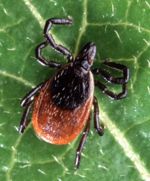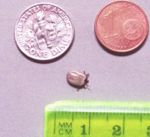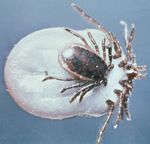Ticks
| This article has been peer reviewed but is awaiting expert review. If you would like to help with this, please see more information about expert reviewing. |
Introduction
Ticks are ectoparasites which live by haematophagy on the blood of mammals, birds and sometimes reptiles and amphibians. Ticks are of considerable veterinary importance, particularly in warmer climates where they can cause substantial economic losses through decreased productivity and most importantly by disease transmission. They are also important in human medicine as they cause Lyme Disease (borreliosis) and tick-borne encephalitis/meningoencephalitis.
Ticks decrease productivity by causing fleece and hide damage, preventing animals from feeding (tick worry), ascending motor paralysis and anaemia. Infestation can also lead to secondary infection from blowfly and screw worms leading to strike.
The soft ticks are only of importance in warmer climates, whereas the hard ticks cause significant problems in both warmer and temperate climates.
Morphology
Hard ticks
- Hard, chitinous covering over dorsal surface called the scutum
- Unique to hard ticks
- Males have a scutum which covers the entire body surface
- Females have a scutum which only covers a small area behind the head
- Prominent biting mouthparts
- Festoons ('pie crust edging') around the posterior body margins
- Enamel coloured patches on scutum are present on ornate ticks
- Female hard ticks may swell up to 3 times their normal size when taking a blood meal
Soft ticks
- No scutum
- Mouthparts are not visible from dorsal surface
- Feed little and often as cannot swell as much as hard ticks
Mouthparts
- Sensory organs for locating a feeding site called palps
- Chelicerae for puncturing the skin
- The hypostome pushes through the wound made by the chelicerae where backwards pointing teeth lock the mouthparts into the skin
- Dorsal groove in the hypostome permits the flow of tick saliva and host blood
Feeding
- Ticks stand upright
- Chelicerae cut through skin creating a pool of blood
- Hypostome is inserted deep into the skin
- Mouthparts are cemented into place
- Ticks feed continuously
- Tick saliva flows into host and contains
- Histamine blocking agents to minimise the host inflammatory response
- Anticoagulants to ensure the free flow of blood
- Cytolysins to enlarge the feeding lesion
- Vasoactive mediators, enterases and carbohydrate splitting enzymes to increase the vascular permeability, facilitating feeding
- Paralytic toxins
- Host tissue is broken down leaving a zone of necrosis creating a feeding lesion
Life cycle
- Ticks are temporary parasites so only spend a short period of their lives on the host species
- When larvae are seeking a host they are known as seed ticks
- Both hard and soft ticks have the same life cycle
- Egg → larva → nymph → adult
- Soft ticks feed little and often and on many hosts
Hard ticks
- Classified depending on the number of host species they parasitise during their life cycle
- Take one blood meal at each life cycle stage which lasts several days
- One-host ticks
- Each stage feeds and develops on one host (the same host)
- E.g. Boophillus spp.
- Two-host ticks
- Larvae and nymphs feed on one host
- Adults feed on a second host
- E.g. Hyalomma
- Three-host ticks
- Each stage feeds and develops on a different host
- E.g. Ixodes spp.
Disease transmission
- Trans-ovarian transmission
- Infection is passed from one generation of ticks to the next through the egg
- E.g. Babesia
- Trans-stadial transmission
- Parasite or microbial organism is ingested during feeding
- Organism passed onto the next host as the tick develops (only in two and three host ticks)
- It is not passed onto the next generation through the egg


